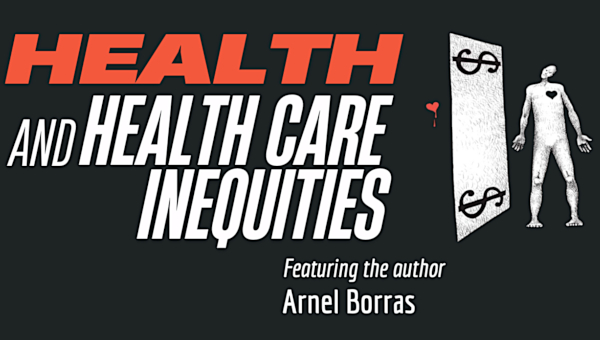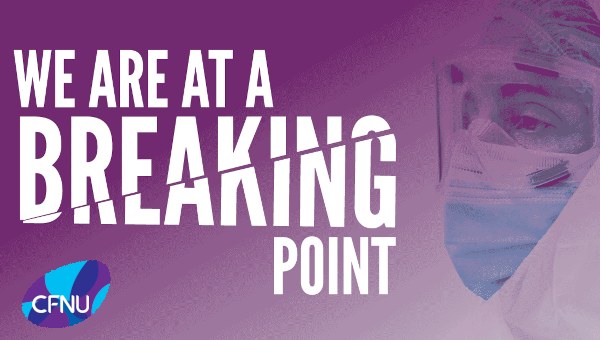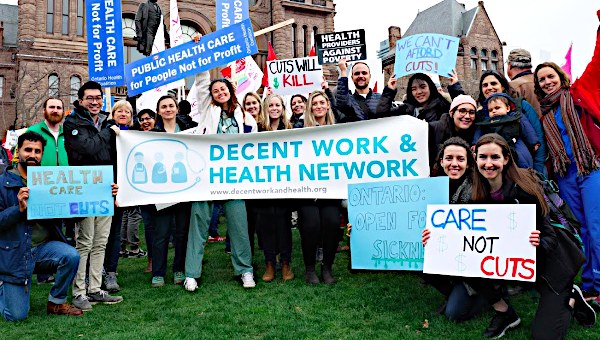The Bio-Economic Pandemic and the Western Working Classes
“Sick… guess we didn’t move quick enough after all…” — Stephen King, The Stand.
The Covid-19 Shock Meets an Impending Economic Recession
As of March 2020, the world is back to the future. The global financial crisis of 2007-08, which escalated into a global financial meltdown in September 2008, was supposed to be the big bang crisis, a once in a lifetime event. And yet, here we are again.

The Russia-Saudi Arabia oil dispute of early March 2020, which has led to a freefall in the price of crude oil and was directed at the US fracking industry, as well as the economic shocks resulting from the globalization of the Coronavirus seem to have caused a new global recession. This has been declared by numerous mainstream economists like Harvard’s Kenneth Rogoff and Pankaj Mishra who are convinced that the world has already entered a new global economic crisis. A few days later central bankers like Germany’s Bundesbank chairman Jens Weidmann announced his expectation that a recession was “probably inevitable by now.”
Most people’s thinking is determined by the development of the Covid-19 crisis, the return of “the hour of executive power” (Gerhard A. Ritter), i.e. state of exception legislation, and the fears which it evokes as well as the economic measures which appear to be in response to the health crisis. By disrupting international supply chains and severely harming a highly vulnerable just-in-time production global economy, Covid-19 clearly accelerated the transition into recession; and yet, this recession was already upon us by the end of last year.
Origins of the Current Financial Crisis
GDP growth, capital profitability, capacity utilization, volume of working hours, etc. were already indicating the onset of a recession. In 2019, countries like Germany, for instance, already saw the lowest growth rates since 2009, the peak of the global financial crisis. In addition, mass layoffs in the global automobile industry were no longer mere results of computerization or the transition to e-mobility but connected to a slump in economic activity. Eric Toussaint is correct when he notes that “the poor health of the … economy dates back well before the first cases of coronavirus in China and its effects on the world economy…. [T]he Fed and the mainstream press are not telling the truth when they state that [measures taken are] designed to deal with the coronavirus.”
Still, the shutdown due to Corona has finally made the general public realize that the world is back to the kind of situation it faced in 2008. In the second week of March, stock markets plummeted and trading was even temporarily halted. From 4 March to 18 March, the Dow Jones Index dropped from 27,091 to 19,899 points; the German DAX dropped from 12,128 to 8,442 points in the same period. Monday, 9 March 2020 was the worst day on Wall Street since 2008 when the Dow Jones dropped by 2,000 points alone. And while pro-labour economists like the German Stephan Kaufmann demanded a shutdown of stock exchanges in order to halt the volatility and panic-induced downward spiral (similarly to the 1997 Asian crisis or the 9/11 crash of 2001), in the US Wall Street quickly demanded “shock and awe stimulus” to halt the economic fallout.
In a botched attempt to protect both ‘investor confidence’ and re-electability, the right-wing Trump administration in the US initially tried to downplay the depth of the health crisis. It was soon joined by the Conservative government of Prime Minister Boris Johnson in the United Kingdom which tried the same. According to Trump, addressing the US public in a live broadcast from the Center for Disease Control in Atlanta, Georgia, the Corona virus was little more than the regular flu, which also caused a limited number of people to die every year with a lethality rate of 0.1 per cent. Precious time had been lost, given that US intelligence agencies had sent classified warnings to President Trump that a pandemic was coming. Similarly, in Germany domestic producers of vital medical protection-wear clothing had warned the German Ministry of Health Jens Spahn (CDU) of an impending pandemic and shortages in supply as early as 5 February, without receiving a reply.
While the exponential curve of infections began to rise steadily, President Trump was addressing the public with statements like: “We’re going substantially down, not up”; “And this is their new hoax!”; “I don’t need to have the numbers double because of one ship that wasn’t our fault.”; “It will go away. Just stay calm, it will go away.” Until in mid-March he switched to “I’ve always known this is a, this is a real, this is a pandemic.” Then it became obvious how serious the health crisis is, Trump resorted to racism and called the virus the “Chinese virus” or the “foreign virus,” inciting racist attacks on Asian-Americans and echoing the deadly racism which blamed the medieval Black Death on Jews, the 1832 cholera on Irish Catholic immigrants, and the 1876 smallpox outbreak on Chinese. Meanwhile right-wing pundits began blaming Democrats and their attempt at impeachment for having slowed down Trump’s otherwise quick response to the emergency.
Racism also played a role in Europe, when the skiing industry in Austria ignored the fact that the resort in Ischgl was the secret origin of the Coronavirus in Europe and kept it operating for an extra eight days blaming the virus on “an Italian” visitor even though other countries like Iceland had already quarantined tourists returning from the Austrian Alps.
Similary, Brazil’s far-Right president Jair Bolsonaro, having just met with Donald Trump, had to be tested for the Coronavirus after he had also called the crisis a “fantasy,” and would later plead with socialist Cuba to send doctors whereas the conservative British prime minister Boris Johnson for a short while even entertained the crazy libertarian idea of herd immunity on national television according to which the British population should be exposed and infected with the Coronavirus all at once in order to “get it over with.”
Given the Coronavirus’ lethality rate, which is estimated between 1 and 5 per cent, and given that even German Chancellor Angela Merkel estimates that up to 60 to 70 per cent of the population will eventually have been infected, Johnson’s suggestion essentially amounted to tolerating, in a social-Darwinist human experiment, the potential death of hundreds of thousands, maybe even millions of old people and people with pre-existing conditions in the UK, a veritable geronticide.
In Germany, the same kind of “epidemiological neoliberalism” was suggested by the right-wing libertarian columnist and big business lobbyist Thomas Straubhaar, while in the Netherlands the government now appears to be pursuing this approach, based on the disturbingly misanthropic, utilitarian calculation that it will be (macro-)economically more efficient to let 40,000 to 80,000 people die rather than to disrupt the economy through massive state measures such as lockdowns. Interestingly enough, in this case it was not the far-right suggesting this policy, yet strong opposition came from that quarter in the form of Geert Wilders’ Party for Freedom.
The Coronavirus Meets Neoliberal Healthcare Systems
By now, with curves of infections skyrocketing exponentially – especially in the UK, the US, and Turkey – and impending healthcare crises upon us, voices in the West, which see a gargantuan policy and planning failure with regards to the Coronavirus when compared to the efforts of China where the virus first occurred on 1 December 2019 or Singapore, Taiwan, and Vietnam, have gained traction.
“China Bought the West Time [and] The West Squandered It” opined the New York Times on 13 March and concluded: “China’s leaders did fumble at the very start, yet in short order they acted far more decisively than many democratically elected leaders have to date.” In fact, World Health Organization experts have been praising the swift efforts by the Chinese government, authoritarian as it may be, which led even the leading German conservative newspaper, the Frankfurter Allgemeine Zeitung (FAZ), to conclude that “the temptation to half-hearted measures is big, because the necessary restrictions to mobility come at a high economic price. This price will however be topped by the price of insufficient measures. o dust off an old motto: ‘Learning from a big brother means learning how to win.’ With her painfully draconian measures, China has succeeded in stopping the spreading of the virus. It does not take much to predict that the country will soon be more secure than the rest of the world.”
Indeed, by 19 March 2020, China reported not a single new infection at the same time that the number of casualties in Italy surpassed that of the “Middle Kingdom” – and at the same time that China’s economy was restarting with workers returning to their workplaces.
It is however not just a question of half-hearted measures of whether or not the West will be able to weather the storm of Covid-19. The virus hits Western capitalist countries under adverse conditions. This can be seen already in Italy and Spain, which in mid-March were said to be a couple of days to two weeks ahead of the rest of the West, and it will very soon be seen in the rest whether the curve of infections rises as steep or even steeper than in the two Southern European countries.
In Italy and Spain, Covid-19 wreaked havoc because, during the “Eurozone crisis” commencing in 2010, the EU’s “Fiscal Compact” forced these peripheral EU countries into adopting severe austerity measures and massive budget cuts in healthcare. For instance, according to the most recent Eurostat data, the various Memorandums of Understanding which the Troika (European Commission, European Central Bank, and IMF) forced Greece to sign entailed not only drastic cuts in pensions and minimum wages levels but also caused healthcare expenditures to drop by 22.4 per cent between 2011 and 2016. According to Eurostat, In Italy healthcare expenditures relative to GDP dropped from 9.0 to 8.8 per cent despite a growth in population from 59.2 million to 60.7 million people over the same period. These short-term budget cuts due to austerity measures were reinforced by the long-term restructuring of healthcare provisioning under neoliberalism, which transformed a system oriented toward public goods provisioning into a cost-cutting operation trimming public health systems into underfunded competitive quasi market institutions.
In total, around €37-billion were taken from Italy’s public health system, the number of hospitals cut by 15 per cent, the numbers of staff – doctors, nurses and social workers – heavily reduced and a total number of 70,000 hospital beds cut, i.e. 17 per cent of the total number of hospital beds. Elio Rosa writes: “This situation has meant that, compared to the European Union average of five beds per thousand inhabitants, Italy now has just over three.” And the reduction of hospital beds also included intensive-care beds. In a country of more than 60 million inhabitants and a generally aging population, their number was reduced to 5,200. Even prior to Corona these beds were largely occupied.
Similar things could be said about a Eurozone core-country like Germany, where – despite generally higher per capita spending on healthcare – hundreds of public hospitals have been privatized and public hospitals closed, where the number of hospital beds per 100,000 inhabitants dropped from 832 in 1991 to 602 in 2017. Nonetheless, in 2019 the influential Bertelsmann Stiftung suggested closing 50 per cent of German hospitals.
In the US more than half of counties have no intensive-care beds at their disposal, putting more than 7 million people who are 60 or older at risk. Budget cuts led to the closing of 20,000 hospital beds in the city of New York alone, where 29 million people have no health insurance and where losing your job usually also means losing your healthcare coverage (if you had any)
The deadly disease is already providing the private, for profit healthcare industry with windfall profits. US pharmaceutical companies used the crisis to double the price on potential coronavirus treatments. Some individuals are facing US$35,000 in medical bills for a few days of COVID-19 outpatient treatment.
In Britain, doctors have been warning about the severe consequences of National Health System funding cuts facing the UK during the Coronavirus crisis. As a doctor warned in an article published in the New York Times: “Britain has fewer intensive-care beds than most other European countries. Occupancy rates are high, and there’s a daily struggle to discharge enough people to make space for new patients. Even when a bed is available, we do not have the nurses to staff it. A decade of cuts and underfunding has left us dangerously exposed.” As Sam Gindin has pointed out;
“The pressures that come with globalization have made a virtue out of restraining, if not reducing, health budgets …. At the same time, the profitability advantages of economies of scale and specialization … have led to extended value chains – production structures, including that of medicine, that involve multiple inputs from multiple plants in multiple countries. Add the near-universal business identification of any excess capacity with unnecessary waste (‘lean production’) thereby underplaying the significance of a degree of flexibility, and you have local medical systems left vulnerable to even minor interruptions and lacking the capacity to confront unexpected emergencies. To globalization as an economic curse is added the medical curse of undermining the domestic ability to prepare for, and respond to, potential pandemics.”
Furthermore, the private and for-profit organization of healthcare ensured that Covid-19 would emerge as it did in the first place. David Harvey observed that:
“Corporatist Big Pharma has little or no interest in non-remunerative research on infectious diseases (such as the whole class of corona viruses that have been well-known since the 1960s). Big Pharma rarely invests in prevention. It has little interest in investing in preparedness for a public health crisis. It loves to design cures. The sicker we are the more they earn. Prevention does not contribute to share-holder value. The business model applied to public health provision eliminated the surplus coping capacities that would be required in an emergency. Prevention was not even an enticing enough field of work to warrant public private partnerships…”
Today, we are harvesting the outcomes of these economic measures. In Italy, where the Corona outbreak started earlier than elsewhere in Europe, doctors have described the Coronavirus as a “war” and “a Tsunami which has overwhelmed us.” The Italian healthcare system was simply not prepared for the Coronavirus crisis. As a result, doctors soon found themselves in a situation where they had to select those who must die – the very old and those with several pre-existing conditions – and those who shall receive respirators and will therefore have a chance to live. Other patients are directly referred to the station for palliative medicine, i.e. where patients are sent to die.

All the while, nurses and doctors, who are exposing themselves and their relatives to the highly infectious Coronavirus, are working 18-hour shifts without days off and are finding themselves on the verge of physical and mental collapse. Crematoriums are in operation around the clock and the coffins are lining up. In Spain Defense Minister Margarita Robles reported how emergency units of the military are finding old people “totally abandoned and dead” in their homes. In mid-March, pictures of Italian military convoys leaving the city of Bergamo and transporting ‘excess corpses’ out of the city shocked the international public.
As a result, waiting lists have developed for funerals, while regular funerals are impossible due to the quarantine. In the region of Lombardy, the local newspaper, L’Eco di Bergamo, extended the obituary pages from the usual 2-3 to 10, because of the excess deaths, listing 150 obituaries per page, with 90 per cent of these deaths linked to the virus. Because people who could theoretically be healed with infusions of extra oxygen and other treatments do not receive this care, the lethality rate of Covid-19 has shot up to 10 per cent.
It is clear that people in Italy are dying not because Covid-19 is so lethal, but because the neoliberalization of healthcare and the EU’s austerity measures are literally killing them. From a medicinal standpoint, the overwhelming majority of deaths are preventable deaths. The selection mechanisms are breaking the hearts of care workers whose task it is to save lives. Doctors report “nurses with tears in their eyes because they cannot save everybody.” As events unfold and the situation deteriorates, people experience it like the nightmares of Stephen King’s The Stand or Steven Soederbergh’s “Contagion.”
“Epidemics,” writes Anne Applebaum in The Atlantic with regards to the special vulnerability of the US’s dysfunctional healthcare system that leaves 29 million people uninsured, “have a way of revealing underlying truths about the societies they impact. This one has already done so, and with terrifying speed … American dysfunction is … the result of our bifurcated health-care system, which is both the best in the world and the worst in the world, and is simply not geared up for any kind of collective national response. The present crisis is the result of decades of underinvestment in civil service, of undervaluing bureaucracy in public health and other areas, and, above all, of underrating the value of long-term planning.”
The Coronavirus Crisis Meets the Working Class
In her first-ever emergency national television proclamation of 18 March 2020, German Chancellor Angela Merkel said that “a pandemic shows how vulnerable we all are and how much we depend on the considerate behavior of other people and thus also on how we protect ourselves through common action and common strengthening.” Even leftists praised Merkel for her calm, liberal and science-oriented approach to the crisis which seems so far apart from the Trumps, Bolsonaros and Johnsons of the world.
Many people have also accepted the lure of Merkel’s message of cross-class sacrifices. After all, is the crisis not affecting everyone regardless of status and wealth? And is the crisis not bringing people together, while national leaders speak the language of solidarity? Has the crisis not led to a situation where suddenly parties and ideologies seem to have become irrelevant?
Well, as most things in life and just like the deadly 1918-1919 Spanish Flu, vulnerabilities during a crisis have a strong and distinct class bias. The most obvious and direct way in which social inequalities impact the capitalist and the working classes differently in a health crisis is displayed by the new phenomenon of concierge doctors. These are doctors which only provide healthcare services to wealthy private customers who are paying for around the clock care. During the coronavirus crisis, the rich are getting tested for the virus, even if they do not show any symptoms, they receive oxygen concentrators, respiratory masks, etc., while workers who are showing signs of COVID-19 are struggling to get tested and pay the bills. Testing has been identified as (one of) the key reason(s) why East Asian countries have been able to flatten the curve.
When everybody must opt for flight instead of fight,the wealthiest capitalists simply have the resources others do not. They flee in their own ways. Private jet travel has experienced a tenfold increase. Billionaires like Silicon Valley giant Peter Thiel, who owns a 477 acre estate in New Zealand, are escaping to their safe domestic country home or offshore hideouts, where the same lockout will feel distinctly different compared to how it feels for the working class.
The indirect ways of how class and social inequality determine the impact of the health crisis are even more severe. In order to contain the spread of the COVID-19, Western governments have shut down public life – sport events, concerts, theaters and later also universities, schools and daycare facilities, etc. – in order to limit social interactions, which would spread the Coronavirus. The universal goal has been to ‘flatten the curve’ of infections.
However, Western governments have largely failed to provide the means of doing so. In many Western countries, with the exception of states like Denmark and Sweden, “social distancing” was to a large extent individualized, at least initially. And even in Denmark and Sweden, the way in which states ensured that workers could stay at home heavily favored capitalist interests. In Denmark, the state asks companies to pay only 25 per cent of sick pay in exchange for a waiver of five full vacation days by workers, which means that the crisis comes at zero cost for the employers if the lockdown does not exceed 20 working days while the workers essentially pay for their sick pay through their taxes. In Sweden, the central government legislated a 300 billion kroner support package (amounting to 6 per cent of GDP) which included the state now covering the full costs of all sick leave which is normally paid for by capital.
In Germany, due to fears of a new great recession, the shutdown of public activities did not include a lockdown of economic activities in manufacturing and other sectors of the economy not directly connected to preserving food sovereignty. For instance, the German health minister, Jens Spahn (Christian Democratic Party), proclaimed that it was easier to give up public sport events and theater plays than on everyday work. Initially, his government simply advised workers to shift to home-office work (“everyone can and should help slow down the Coronavirus”), even though for the vast majority of the working class this is not an option and even though in the big cities work still necessitates many workers relying on public transit where the proximity of commuters all but ensures a spread of infections.
Even after the German government legislated, on 22 March, highly intrusive measures that would prosecute and heavily fine any public gathering of more than two people, giving a new meaning to the saying “two’s company, three’s a crowd,” no lockdown was put in place and non-essential businesses continued operations.
However, faced with the fallout of interrupted international supply chains, the new recession and a full work stoppage in the German automobile industry, the German grand-coalition government of Christian Democrats and Social Democrats initiated involuntary short-term labour transfer payments (“Kurzarbeitergeld”) of 60 per cent of previous income – 67 per cent for parents with children – as a means to supplementing reduced work-hours, protecting jobs and preventing mass layoffs. These measures reintroduced policies already and successfully tried during the global financial crisis of 2007 onwards. They were echoed by similar programs in Denmark and in Sweden.
Back in 2009-10, the success of these programs was reflected in the ways in which German manufacturers did not have to shed their workforce and could simply reignite production and again seize market shares when the economic recovery began. Yet, the German Trade Union Confederacy (DGB) correctly criticized that this was not enough for workers in the low-wage sectors, the most hard-hit by the fallout of the Coronavirus crisis.
Still, in the vast low-wage sector of Germany’s economy, which employs 1 of every 4 workers, 60 per cent is not enough to put food on the table and pay the bills. The DGB and the service sector union Ver.di therefore pushed for an expansion of “Kurzarbeitergeld” to 90 per cent of previous incomes.
Precarious workers such as the self-employed, freelancers as well as shop-owners are not protected by these measures because they do not fall under any kind of collective bargaining agreement. The Coronavirus crisis and the resulting shutdown hit them directly. Only some countries like Sweden cover the self-employed in providing 14 days of sick pay. In Norway, Spain and Italy there now exists a €600 payment for all self-employed people and freelancers, who fall under a so-called “Partita IVA” tax codes.
The worse off are people in the gig economy. In Italy, workers in the informal economy are left with nothing, including the 2 million workers who used to be employed as maids, elderly caregivers and childcare providers (of which nine out of ten are women and around 7 out of 10 are immigrants), who are now made redundant by the return of their employers into their private households. Generally speaking, the poor were hit the worst by the situation as minimal savings dried up and charity soup kitchens like Germany’s Tafel closed, quickly creating a situation of general food insecurity. In response to this the World War Two members of the Left Party (Die Linke) started to create soup kitchens, an effort resembling the pre-World War Two self-help initiatives of the working class. Might we even see the return of workers’ councils organizing social infrastructure where the state is failing to provide it?
In other Western states the situation is even worse than in central Europe. In the United States, the biggest employers refused to lock down their businesses and provide their workers sick-pay. Here, capitalism’s structural constraint of uninterrupted capital accumulation confronts workers with the terrible choice between evictions and possible starvation. As Mark Bergfeld correctly stated, “The problem is, the culture of ‘presenteeism’ places the burden of the decision on workers – often meaning they’ll turn up to work when they should be staying home.”
The largest “companies putting profits ahead of public health” include McDonald’s with 517,000 workers, Walmart with 347,000 workers, Kroger with 189,000 workers, Subway with 180,000 workers, Burger King with 165,000 workers, Pizza Hut with 156,000 workers, Target with 151,000 workers, Marriott with 139,000 workers, Wendy’s with 133,000 workers, Taco Bell with 124,000 workers, Dollar General with 109,000 workers, Applebee’s with 99,000 workers and Dunkin’ Donuts with 97,000. All of this is happening in a situation where, according to the May 2019 Federal Reserve’s Report on the Economic Well-Being of US Households in 2018, 40 per cent of Americans could not meet an emergency expense of US$400 without borrowing money; where, in other words, close to half the population is one paycheck away from homelessness.
While Starbucks workers reportedly begged their corporate overlords to shut down stores, the Trump administration initially announced only one program aimed at providing assistance to the working class. This included sending government cheques which are supposed to amount to a maximum of US$2,000. Of course, this is also connected to Trump’s desire to be re-elected. For obvious reasons, direct cash payments from the government are a popular way of ensuring this (George W. Bush pursued the same strategy).
On 17 March 2020, Treasury Secretary Steven Mnuchin announced that the first cheques “of at least $1,000” were to be sent out by the end of April, a second cheque would follow in May. Needless to say, this sum will not enable workers to stay home from work and pay their bills. Nothing short of sick-pay for all workers and a moratorium on rents, utility payments, mortgages, student debt and credit card debt repayment (which so far only France has legislated) can ensure that the working-class manages to get out of this crisis. It is in light of this context that the defeated US presidential candidate Bernie Sanders has therefore called for a monthly payment of US$2,000 to every US household in order to enable workers to stay home and prevent millions of excess pandemic deaths in the United States.
All the while, US billionaires went so far as to call for an end to even the limited healthcare provisions by the Trump administration to compel workers to return to work despite the dangers this would entail. The multi-billionaire and defeated Democratic primaries candidate Michael Bloomberg made news for firing his former staff members after having informed them that they were exposed to the coronavirus, leaving them without healthcare coverage by month’s end.
Incidentally, the hypocrisy of US politics and its two-party system was on full display throughout this. The idea of sending checks to all US workers was also circulated among the Democratic party leadership, yet Nancy Pelosi orchestrated its rejection in favor of means-testing. This reservation was later seconded by senate minority leader Chuck Schumer (D-NY). Now, because the suggestion originates from President Trump, when election day comes in November, he will be able to say he stood up for workers while the Democrats wouldn’t, even though he conducted the worst attacks on the working class by cutting social programs and by tearing a gigantic whole into the state budget with his slashing of corporate and marginal tax rates for capital and the super-rich.
In Canada, the right-wing provincial government of Ontario has not done any better. Instead of paying sick-leave for all workers, its response to the crisis entailed “allowing” workers to waive the requirement of attaining a doctor’s notes to take unpaid leave. In the UK, it took the Tory government a long time to extend sick pay to all workers in self-isolation, even if they were not infected with the coronavirus. Given that the amount paid by the government was only £94 per week, this essentially meant that people would have to continue working as long as there was not a moratorium on the costs mentioned above. It was only when it became clear how serious the health crisis was that the government changed course. Chancellor of the Exchequer Rishi Sunak announced the far-reaching measure that all workers unable to work during the coronavirus crisis would receive up to £2,500 per month.
Generally speaking, these measures, or rather, this relative governmental inaction at a time of crisis left the global working classes tremendously vulnerable. In the current crisis, it is clear that it is not bankers, hedge fund managers or lawyers who are “too big to fail.” Rather it is the farm workers, supermarket cashiers, garbage collectors, doctors, nurses, personal care aides, and couriers who are attempting to ensure food sovereignty and healthcare provisioning. If ruling elites now point rhetorically to the ‘systemic relevance’ of the working class, it is not clear that such ‘recognition’ will turn into material remuneration.
It is especially supermarket cashiers, who are bearing the brunt of the collective mental stress the Coronavirus crisis has caused, when customers fight over noodles, rice and toilet paper and do not accept that they must not clear entire shelves etc. And next to paramedics, flight attendants, policemen and women, barbers, childcare workers, maids, janitors and many manufacturing workers, these segments of the working class and their elderly and sick family members are most vulnerable to the Coronavirus given either their exposure to diseases and/or their proximity to others while working.
Moreover, the lack of sick-pay and moratoriums on regular bills simply forced large swaths of workers, who cannot work from home, to go into work every day in order to stay afloat. This, of course, means that ‘flattening the curve’ becomes an illusion. It threatens the working class with death, because it is the workers who are at the frontline of the Coronavirus. In his famous essay on The Housing Question, Friedrich Engels once noted on epidemics: “Capitalist rule cannot allow itself the pleasure of creating epidemic diseases among the working class with impunity; the consequences fall back on it and the angel of death rages in its ranks as ruthlessly as in the ranks of the workers.”
In the current conjuncture, this is theoretically true but not in practice. It is the workers who are risking infections by going to work, who are risking infecting their elder and sick relatives. It is they who usually lack both larger homes with gardens as well as the funds to leave in order to wait it all out at largely unaffected tourist resorts. It is therefore workers who are running a much higher risk of stress, marital strife and domestic violence (reported as a horrific side-effect of the Italian setting). It is also those who are forced to go into work while their children are out of daycare and out of school and who therefore often cannot refrain from exposing their elder and retired relatives to their children. It is thus they who are forced to choose whether to not work and become evicted or go to work and risk killing their elder relatives either through infections they bring home or through having their own children infect them.
The Response of Working Classes So Far
The working classes of the West have not simply accepted this intolerable situation. In Germany, labour unions were successful in expanding the government’s involuntary short-term labour payments from 75 to 97 per cent of previous net-income. In the German food industry, one of the key low-wage industries hit the hardest by the crisis, the trade union NGG and the employers arranged a 90 per cent payment of short-term labour pay, retroactive to 1 March 2020. Given that only 47 per cent of German workers benefit from collective bargaining coverage, the most challenging class struggle is the fight to force the Merkel government to increase guaranteed incomes to 90 per cent for all workers in order to protect the weakest and poorest segments of the German working class. In Norway workers already won similar gains.

In other countries, workers have resorted to wildcat strikes. In Italy, such strikes have occurred at Fiat via the shipbuilding industry in Liguria in northern Italy to the steelworkers in the South and also in the aerospace and arms industry, seeking to force governments into negotiations with the labour unions. In Spain, wildcat strikes occurred at Mercedes and Iveco, while at Volkswagen the labour unions refused to continue production.
In the US, auto workers at Fiat-Chrysler’s Sterling Heights Assembly Plant in Michigan went on strike after they learned that some of their co-workers had been quarantined because of the coronavirus. In Detroit a strike by bus drivers ensured that fares would “not be collected for the duration of the coronavirus crisis.” And in New York workers at a cafe started to organize when faced with the impossible choice of either continuing to work and infecting themselves or calling in sick, losing essential income and risking homelessness. At Amazon’s DCH1 Chicago warehouse, angry and determined workers organized and won a fight for a shutdown with full pay, showing other Amazon workers how Paid Time Off (PTO) can be won.
The size and dynamism of such workers’ struggles is likely to increase with the intensification of the coronavirus and economic crises. At the same time, the fact that they need to occur out of a situation of desperation shows how unlikely ‘flattening the curve’ is going to be and how likely working-class families are going to suffer from the coronavirus crisis and are going to carry most of the burden.
In a commentary in Jacobin on Italy’s decision to finally move ahead with a lockdown of the economy, David Broder points out that “The crisis has strikingly illustrated that public health concerns us all – faced with the spread of COVID-19 no one is really safe unless everyone is. But that doesn’t mean we all face this crisis as equals. Employers will still try and profit, and workers depending on the next paycheck will still have to work unless the state intervenes to ensure they don’t.” This will depend on the organizational capacities and creative political strategies of the working classes to enforce the workplace protections and public health provisioning for their own – and society’s – healthcare needs. •





